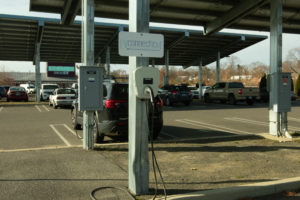
The New Year will bring with it both fresh opportunities and regulations courtesy of the Connecticut Public Utilities Regulatory Authority (PURA).
Starting Jan. 1, a nine-year program to provide homes and businesses with incentives for installing electric vehicle charging stations will go into effect. First announced back in July, the implementation of this statewide electric vehicle charging program is the first part of PURA’s Equitable and Resilient Grid Initiative to have a direct impact on businesses and consumers outside of the utilities that PURA regulates.
“The new statewide program seizes the opportunities for ratepayers that come from electrifying our transportation sector, as the program will facilitate a proactive approach and seamless integration of new and emerging EV technologies across our state’s electric grid,” said PURA Chairwoman Marissa P. Gillett when the program was first announced. “Electric vehicles not only provide an opportunity to decarbonize the transportation sector, but also the potential to lower electric rates ”“ a much welcome outcome for all Connecticut ratepayers.”
The program will be administered by The Connecticut Light and Power Co., Eversource Energy and the United Illuminating Co., with the latter two utilities being directed by PURA to offer a series of financial incentives to customers who want to install car charging facilities. Rebates of up to $500 and partial coverage of electrical upgrades will be available for single-family homes while multi-unit dwellings and public destinations can have up to 50% of the charger’s cost and 100% of the installation costs covered so long as they are installing at least two charging ports.
Most of the state these funds will be capped at $20,000 while locations in designated underserved communities will be able to draw up to $40,000 from the program’s Equitable Modern Grid Initiative. PURA stated that it hoped to bring this technology to the communities that currently have the least access to it, primarily poorer urban areas and more isolated rural communities.
Workplaces can also take advantage of these offers, but they must install at least four ports for employees to charge vehicles at during the day. The maximum incentive per location is the same, with $20,000 as a baseline, doubling to $40,000 in disadvantaged communities.
The comparatively low cost of Level 2 car chargers means that these incentives have the potential to cover a considerable amount of the cost installation for Connecticut residents and business owners.
Standalone Level 2 chargers typically range from around $200 to $600 and are sold by big box retailers including from Home Depot to Walmart. According to cost estimate aggregator HomeGuide.com, having a qualified electrician perform the installation runs between $400 and $1,700. Commercial grade charging systems such as Chargepoint are more expensive, but they come with advantages such as networking and apps that improve the system’s efficiency and spaces for branding or advertisements.
The program also offers up to 50% of the cost of a direct current fast charger and up to 100% of the cost of installation for at least two ports. Otherwise known as a Level 3 Charger, these chargers are considerably more expensive to purchase and install, and the maximum per site incentive is raised to $150,000 as a baseline, with installers in underserved communities receiving incentives up to $250,000.
The emphasis on Level 2 chargers stems from being a comparatively simple upgrade from a Level 1 charger (which can simply plug into a wall outlet) while being able to charge cars several times faster. A Level 2 Charger can be either hardwired or plugged in but requires a power source of at least 200 volts much like many large home appliances.
Level 3 chargers are several times faster again, able to charge some models of electric vehicle from nearly empty to full in an hour instead of overnight, but not all electric vehicles are capable of taking full advantage of that ability, and installation is considerably more complex.
The program is aimed at assisting the state in accomplishing the renewable energy obligations set forth in a July 2020 Memorandum of Understanding between Connecticut, 14 other states and the District of Columbia. Connecticut’s contribution to that goal is to put between 125,000 and 150,000 electric vehicles or plug-in hybrids on the road by 2025. Working toward that goal will also help lay the groundwork for the goal of 500,000 zero-emission vehicles across the state by 2050.
The rebates for chargers are just one of 11 points in the Resilient and Equitable Grid Initiative, which will have far-reaching impacts and continue to implement new policies, regulations and policies. Over the next nine years, PURA hopes to conceive and implement transformational changes to the distribution of electricity in Connecticut.
“This framework is an important development in regulatory affairs. This process will help the authority address some very important issues in a comprehensive and structured manner so we can assess their viability, reliability and affordability for Connecticut’s ratepayers and businesses,” said Michael Caron, commissioner of PURA, when the framework was first announced.



















